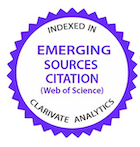Avaliação de amostras de sangue de gado zebuíno nelore usando o analisador hematológico CELL-DYN 3500
DOI:
https://doi.org/10.1590/1089-6891v15i41755Palavras-chave:
Nelore, Cell-Dyn 3500, hematologiaResumo
O Cell-Dyn 3500 é um citômetro de fluxo multi-parâmetros que realiza várias análises simultâneas em diversas espécies de animais. Ele realiza a contagem total de leucócitos, de hemácias e de plaquetas, além do diferencial de leucócitos, o volume globular e a determinação de hemoglobina. O Cell-Dyn 3500 realiza a contagem total de leucócitos, tanto pelo método óptico quanto pela impedância. O equipamento pode escolher um ou outro método, baseado na confiabilidade dos resultados. A contagem de hemáceas e plaquetas é determinada pelo método de impedância. A diferenciação de leucócitos é baseada em um princípio óptico de análise, utilizando-se separação em luz polarizada multiangular. O objetivo deste trabalho foi comparar os resultados de hemogramas, realizados pelo Cell-Dyn 3500, com aqueles realizados por um contador celular semi-automático (Celm CC-510) e pela técnica manual. Amostras de sangue foram colhidas da veia jugular, em tubos de 5,0 ml à vácuo com EDTA, de 58 novilhas Nelore de 24 meses de idade. As amostras foram processadas paralelamente nas três técnicas. Os resultados foram analisados pelo teste t pareado, correlação de Pearson e pelo método de Bland-Altmann. Houve forte correlação entre os resultados hematológicos obtidos pelo Cell-Dyn 3500, pelo método manual e pelo contador celular semi-automático (Celm CC-510), exceto para a contagem de basófilos e monócitos. Esses resultados confirmam que o equipamento é confiável para a análise de amostras de sangue de gado zebuíno.
PALAVRAS-CHAVE: CC-150; Cell-Dyn 3500; hematologia; Nelore.
Downloads
Downloads
Publicado
Como Citar
Edição
Seção
Licença
Copyright (c) 2014 Ciência Animal Brasileira / Brazilian Animal Science

Este trabalho está licenciado sob uma licença Creative Commons Attribution 4.0 International License.
Autores que publicam nesta revista concordam com os seguintes termos:
- Autores mantém os direitos autorais e concedem à revista o direito de primeira publicação, com o trabalho simultaneamente licenciado sob a Licença Creative Commons Attribution que permite o compartilhamento do trabalho com reconhecimento da autoria e publicação inicial nesta revista.
- Autores têm autorização para assumir contratos adicionais separadamente, para distribuição não-exclusiva da versão do trabalho publicada nesta revista (ex.: publicar em repositório institucional ou como capítulo de livro), com reconhecimento de autoria e publicação inicial nesta revista.
- Autores têm permissão e são estimulados a publicar e distribuir seu trabalho online (ex.: em repositórios institucionais ou na sua página pessoal) a qualquer ponto antes ou durante o processo editorial, já que isso pode gerar alterações produtivas, bem como aumentar o impacto e a citação do trabalho publicado (Veja O Efeito do Acesso Livre).






























